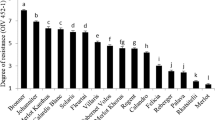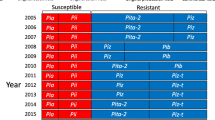Abstract
Caldwell and Prentice1 emphasized in 1942 the value of seed-bed isolation in the control of cauliflower mosaic virus, which in Devon has seriously reduced yields of broccoli. Experimental work at this College has shown that infection in the seed-bed can still be the main cause of reduced yield, even when conditions favour extensive spread of virus in the field after planting.
This is a preview of subscription content, access via your institution
Access options
Subscribe to this journal
Receive 51 print issues and online access
$199.00 per year
only $3.90 per issue
Buy this article
- Purchase on Springer Link
- Instant access to full article PDF
Prices may be subject to local taxes which are calculated during checkout
Similar content being viewed by others
References
Caldwell, J., and Prentice, I. W., Ann. App. Biol., 29, 4, 374 (1942).
Caldwell, J., and Prentice, I. W., Ann. App. Biol., 29, 4, 366 (1942).
Smith, K. M., “Text Book of Plant Virus Diseases”, 9 (1937).
Author information
Authors and Affiliations
Rights and permissions
About this article
Cite this article
JENKINSON, J., JONES, G. Control of Cauliflower Mosaic Virus. Nature 168, 336–337 (1951). https://doi.org/10.1038/168336b0
Issue Date:
DOI: https://doi.org/10.1038/168336b0
This article is cited by
-
Vektorenbekämpfung bei Viruskrankheiten im Gemüsebau?
Anzeiger für Schädlingskunde (1958)
Comments
By submitting a comment you agree to abide by our Terms and Community Guidelines. If you find something abusive or that does not comply with our terms or guidelines please flag it as inappropriate.



